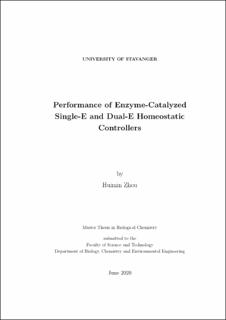| dc.contributor.advisor | Ruoff, Peter | |
| dc.contributor.author | Huimin, Zhou | |
| dc.date.accessioned | 2020-09-29T09:09:55Z | |
| dc.date.available | 2020-09-29T09:09:55Z | |
| dc.date.issued | 2020-06-15 | |
| dc.identifier.uri | https://hdl.handle.net/11250/2680195 | |
| dc.description | Master's thesis in Biological chemistry | en_US |
| dc.description.abstract | Mathematical modeling has become an important tool in order to investigate the behavior of biological systems. The concept of homeostasis is central to our understanding how cells and organisms maintain an internal stability despite environmental or internal perturbations/insults. In this thesis the behavior and performance of two classes of homeostatic controllers are investigated. These two classes di er by the number of controller molecules involved in the homeostatic response. Single-E controllers contain one controller species, while dual-E controllers (antithetic controllers) contain two. A novel aspect of this thesis is the role enzymes can play in the performance of these controllers. For this purpose two controller motifs (negative feedback structures, motifs 5 and 2) have been investigated in detail. Enzymatic considerations included steady state and rapid equilibrium systems of ping-pong and ternary complex mechanisms for dual-E controllers and one-substrate Michaelis-Menten kinetics for single-E controllers. For the steady state systems reaction velocities were derived by the King-Altman method, which showed practically identical results in comparison with numerical calculations. For the motif 5 negative feedback arrangement a dual-E controller has a much better ability to withstand perturbations than a single-E controller. The reason for this is the fact that in dual-E controllers robust homeostasis can be achieved independently of the reaction order involving the removal of the two controller species E1 and E2. The single-E controller, on the other hand, requires zero-order or near zero-order removal kinetics with respect to its controller molecule E. When considering the ping-pong or ternary complex enzymatic mechanisms the dual-E controllers showed no significant differences in their homeostatic behaviors. Finally, the occurrence of enzyme-catalyzed dual-E controllers in physiology is discussed. | en_US |
| dc.language.iso | eng | en_US |
| dc.publisher | University of Stavanger, Norway | en_US |
| dc.relation.ispartofseries | Masteroppgave/UIS-TN-IKBM/2020; | |
| dc.subject | biologisk kjemi | en_US |
| dc.subject | biological chemistry | en_US |
| dc.title | Performance of Enzyme-Catalyzed Single-E and Dual-E Homeostatic Controllers | en_US |
| dc.type | Master thesis | en_US |
| dc.subject.nsi | VDP::Matematikk og Naturvitenskap: 400::Basale biofag: 470::Biokjemi: 476 | en_US |
